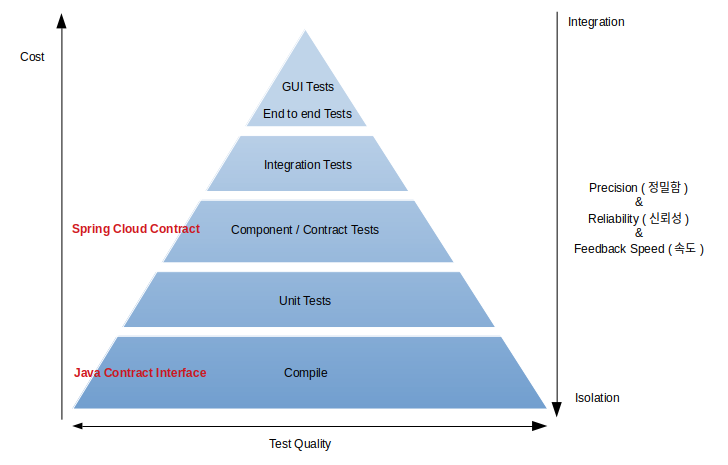Spring @Async AspectJ 비동기처리

( 이미지 출처 : https://upload.wikimedia.org )
이 글은 Spring @Async 비동기처리 에서 알려드린 Spring @Async의 제약사항에 대해 다시 한번 살펴보고
CTW(Compile-Time Weaving)과 LTW(Load-Time Weaving)라는 두가지 방식으로 AspectJ를 이용해서 제약사항을 회피하는 방법을 공유드립니다.
SpringBoot 를 사용했으며 java based configuration 방식을 이용했습니다.
CTW 샘플과 LTW 샘플을 Github에 올려뒀으니 참고하시기 바랍니다.
@Async 와 AOP
Spring @Async는 Spring AOP(Aspect-Oriented Programming)를 활용해서 제공되는 기능입니다.
그러한 이유로 Spring AOP의 특성이나 제약사항을 Spring @Async가 그대로 가지게 됩니다.
Spring AOP는 Proxy 모드와 AspectJ 모드가 존재합니다.
Spring AOP Proxy 모드
PROXY 모드는 Spring AOP의 기본 모드이며, 순수한 Java 코드로 AOP를 구현합니다.
비동기처리와 같은 관점(Aspect)를 특정 method와 엮는작업(Weaving)이 Java 코드가 실행되는 시점에 이뤄집니다.
RTW(Run-Time Weaving)으로 처리된다고 표현하고
특정 method가 호출되는 런타임 시기에 해당 method의 비동기처리 여부가 정해집니다.
AOP는 비동기처리 뿐만 아니라 다양한 목적으로 활용됩니다.
제약사항
- pulbic method에만 사용가능 합니다.
- 같은 객체내의 method끼리 호출시 AOP가 동작하지 않습니다.
- RTW로 처리 되기 때문에 약간의 성능저하가 있습니다.
이 제약사항은 @Async, @Transactional과 같은 Spring AOP를 활용하는 다른 기능들에게도 동일하게 적용됩니다.
Spring AOP AspectJ 모드
AspectJ
AspectJ는 Spring과 별개의 프로그램입니다.
Java로 작성된 코드라면 Spring framework을 쓰지 않아도 AspetJ 만으로도 AOP를 구성할 수 있습니다.
예를들어 Android application에도 AOP를 구성할 수 있습니다.
AspectJ는 두번의 컴파일 과정이 필요합니다.
1차적으로 Java 코드를 컴파일해서 binary 형태의 class 파일을 만들고
2차적으로 binary 파일들을 분석해서 필요한 부분에다가 aspect를 삽입하는 weaving 과정을 거칩니다.
CTW(Compile-Time Weaving)으로 처리된다고 표현합니다.
Spring AOP AspectJ 모드
Spring AOP에 AspectJ를 활용할 수 있습니다.
그 덕분에 @Async annotation과 같이 굉장히 간결한 방식으로 AspectJ의 유연성을 활용할 수 있습니다.
Spring에서 AspectJ를 활용하는 방법은
CTW(Compile-Time Weaving)과 LTW(Load-Time Weaving)로 두가지가 있습니다.
두 방법 모두 Proxy 모드가 갖는 제약사항을 처리할 수 있고
LTW의 경우는 class를 load하는 과정에서만 weaving을 하기 때문에 RTW보다는 성능이 빠릅니다.
CTW는 컴파일시에만 weaving을 하기 때문에 성능이 가장 좋습니다.
대신 Proxy 모드에서 추가적인 설정작업이 필요합니다.
Proxy 모드만으로도 개발하는데 큰 문제는 없습니다.
만약에 AspectJ 모드가 필요하다면 CTW, LTW 중에 한가지 방식을 골라서 설정하시면 됩니다.
이 설정도 Spring이 추구하는 방식대로 소스코드는 수정하지 않습니다.
build.gradle과 configuration 수정만으로 진행됩니다.
갑자기 프로젝트에 CTW 방식으로 @Async를 바꿔야한다고해서 소스코드를 수정되지 않기 때문에
개발자가 개발단계에서 비동기처리를 CTW로할지 RTW로 할지 고민할 필요가 없다는 얘기입니다.
Spring @Async CTW 설정
Spring Async 샘플에서부터 수정해나가는 방식으로 설명하겠습니다.
최종적으로 수정된 CTW 샘플도 참고하시기 바랍니다.
build.gradle 파일 수정
buildscript {
ext {
...
eveohAspectj = '1.6'
aspectjVersion = '1.8.4'
}
repositories {
maven {
url("https://maven.eveoh.nl/content/repositories/releases")
}
...
}
dependencies {
...
classpath("nl.eveoh:gradle-aspectj:${eveohAspectj}")
}
}
...
apply plugin: "aspectj"
apply plugin: 'application'
...
dependencies {
...
// AspectJ - Compile Time Weaver
compile("org.springframework:spring-aspects")
aspectpath("org.springframework:spring-aspects")
}
apply plugin: "aspectj"를 추가할 때 aspectjVersion 변수보다 아래 라인에서 추가해야만 합니다.
SpringAsyncConfig.java 설정 수정
@Configuration
@EnableAsync(mode=AdviceMode.ASPECTJ)
public class SpringAsyncConfig {
...
}
@Async를 AspectJ를 통해서 설정하겠다는 의미로
@EnableAsync를 설정할 때 mode를 AdviceMode.ASPECTJ 로 추가 설정했습니다.
테스트
테스트 내용은 아래와 같습니다.
Controller로부터 service의 method1과 method2가 호출됩니다.
그리고 method2는 method3을 내부호출합니다.
그리고 method3는 private 으로 클래스내의 내부호출만 가능합니다.
Proxy 모드 결과
2016-11-26 18:10:54,216 INFO i.d.s.h.GreetingController [http-nio-8080-exec-1] Hello World
2016-11-26 18:10:54,271 INFO i.d.s.h.GreetingService [Executor-1] method 1-1
2016-11-26 18:10:54,274 INFO i.d.s.h.GreetingService [Executor-2] method 2-1
2016-11-26 18:10:54,275 INFO i.d.s.h.GreetingService [Executor-2] method 3-1
2016-11-26 18:10:54,375 INFO i.d.s.h.GreetingService [Executor-2] method 3-2
2016-11-26 18:10:54,375 INFO i.d.s.h.GreetingService [Executor-2] method 2-2
2016-11-26 18:10:54,571 INFO i.d.s.h.GreetingService [Executor-1] method 1-2
GreetingController에서 Hello Wordl를 추력한 thread의 이름은 http-nio-8080-exec-1 입니다.
GreetingService의 method1을 실행한 thread는 Executor-1이고
Executor-2가 method2, method3을 실행했습니다.
Proxy 모드의 경우 내부호출되는 경우에는 비동기처리가 불가능하기 때문에
method3는 다른 thread로 분리되어 처리되지 않고 Executor-2가 함께 처리했습니다.
CTW AspectJ 모드 결과
2016-11-26 04:30:25,574 INFO i.d.s.h.GreetingController [http-nio-8080-exec-1] Hello World
2016-11-26 04:30:25,580 INFO i.d.s.h.GreetingService [Executor-1] method 1-1
2016-11-26 04:30:25,581 INFO i.d.s.h.GreetingService [Executor-2] method 2-1
2016-11-26 04:30:25,582 INFO i.d.s.h.GreetingService [Executor-2] method 2-2
2016-11-26 04:30:25,582 INFO i.d.s.h.GreetingService [Executor-3] method 3-1
2016-11-26 04:30:25,683 INFO i.d.s.h.GreetingService [Executor-3] method 3-2
2016-11-26 04:30:25,880 INFO i.d.s.h.GreetingService [Executor-1] method 1-2
GreeingService의 method별로 tread명이 각각 다른 것을 확인할 수 있습니다.
내부호출된 method3도 새로운 thread로 실행되는 것을 확인할 수 있습니다.
Spring @Async LTW 설정
작성중입니다.
Associated Posts
관련된 주제를 살펴볼 수 있도록 동일한 Tag를 가진 글들을 모아뒀습니다. 제목을 눌러주세요.-
Spring Boot Configuration & Kubernetes ConfigMap: OS 환경변수 바인딩


( Image reference : https://upload.wikimedia.org )이 글은 OS 환경변수를 Spring Boot의 프로퍼티에 바인딩하는 방법을 다룹니다.
그리고 그 방법을 이용해서 Kubernetes configmap을 Spring Boot 프로퍼티에 바인딩 하는 방법도 다룹니다.이를 이용해서 프로퍼티를 더 간단하고 유연하게 관리 가능합니다.
로컬환경에 필요한 프로퍼티는 application.yml로 관리하면되고
개발환경, 운영환경 등에 필요한 프로퍼티는 각 OS 환경변수 혹은 Kubernetes configmap을 활용해서 관리합니다.... 더 읽기 -
Contract Test 없이 MSA 도전 : Contract Interface

API 제공자(Provider), 소비자(Consumer) 모두 컴파일 단계에서 계약(Contract)의 API spec을 검증할 방법을 제안합니다.
기존에 component, contract 테스트에서 받을 수 있었던 피드백을 컴파일 단계에서 받게되어 개발속도가 크게 향상됩니다.... 더 읽기 -
나의 첫 Pull Request : Spring Cloud Gateway
나의 첫 pull request를 보냈다.
그리고 얼떨결에 Spring Cloud Gateway contributor가 되어버렸다.... 더 읽기 -
Spring Cloud Gateway - Resilience4j, Kubernetes
-
All Properties Of Spring Boot, Spring Cloud
-
Spring Boot, Spring Cloud의 설정정보 모음
-
Spring Boot Auto Configuration 설정과 원리
-
Spring Boot Starter & Parent 로 간단히 의존성 설정하기
-
중복 로그인 방지 in Session Clustering Env
-
Spring RequestContextHolder - 어디서든 HttpServletReqeust 사용하기
-
Spring @Async with Http Session
-
Spring @Cacheable Cache 처리
-
Spring @Async 비동기처리




